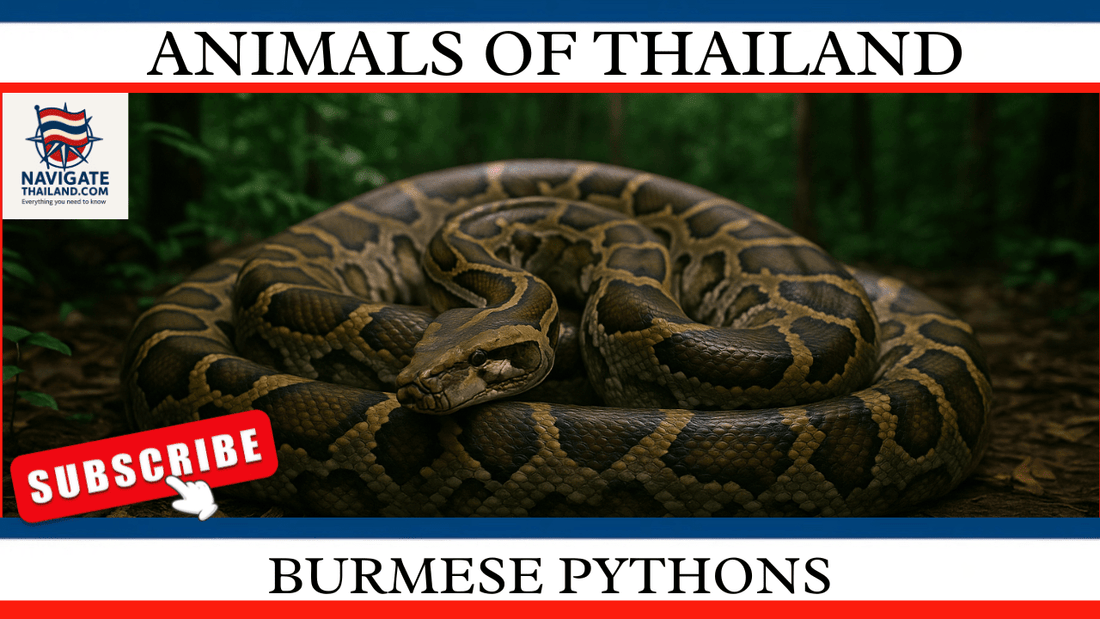
Burmese Pythons: Everything You Need to Know
Share
Burmese pythons (Python bivittatus) are one of the world’s largest and most fascinating snake species. Native to Southeast Asia, these massive reptiles are known for their impressive size, striking appearance, and remarkable hunting skills. However, the story of Burmese pythons extends beyond their natural habitat—this species has also become infamous as an invasive species, particularly in the Florida Everglades, where they have caused significant ecological challenges.
For travellers visiting Southeast Asia or anyone curious about wildlife, understanding the biology, habitat, and impact of Burmese pythons is crucial. In this in-depth guide, we’ll explore everything you need to know about these snakes, including their diet, behaviour, conservation status, and the controversy surrounding their presence in Florida. Along the way, we’ll include fun facts, practical information for encounters in the wild, and insights into their role in both native and non-native ecosystems.
What is a Burmese Python?
The Burmese python is a non-venomous constrictor snake native to Southeast Asia. It is one of the five largest snake species in the world, known for its immense size and strength. Burmese pythons can grow up to 6 metres (20 feet) in length, although some rare individuals in their native habitat have been reported to reach lengths of 7 metres (23 feet) or more. Their muscular bodies, designed for power, enable them to constrict and subdue prey much larger than themselves.
Burmese pythons are generally considered docile, especially in captivity, but their sheer size makes them formidable creatures, requiring respect and caution in the wild.
Physical Characteristics
Burmese pythons are easily recognised by their distinctive pattern of dark brown blotches, bordered by black, against a lighter brown or tan background. This pattern helps them blend into the forest floor or wetlands, making them highly effective ambush predators. These snakes also have heat-sensing pits along their jaws, which allow them to detect warm-blooded prey even in complete darkness.
• Length: Most Burmese pythons grow between 3.7-6 metres (12-20 feet), with females typically being larger than males.
• Weight: They can weigh up to 90 kilograms (200 pounds) or more, depending on their size and diet.
• Lifespan: In captivity, Burmese pythons can live for up to 20-25 years, while in the wild, their lifespan may be slightly shorter due to predation, disease, and environmental factors.
Fun Fact: The longest Burmese python ever recorded in Florida’s Everglades was 5.6 metres (18 feet 8 inches), which is massive for an invasive population but still smaller than some reported wild specimens in Southeast Asia.
Native Habitat of Burmese Pythons
Burmese pythons are native to Southeast Asia, including countries like Myanmar (Burma), Thailand, Vietnam, Laos, and parts of China. They are incredibly adaptable and can thrive in a wide range of habitats, including tropical rainforests, grasslands, wetlands, marshes, and even agricultural areas.
Where to Find Burmese Pythons in Southeast Asia
In their native regions, Burmese pythons are often found near water, as they are semi-aquatic creatures. They are excellent swimmers and can travel long distances through water, which helps them colonise new areas when necessary.
• Thailand: In Thailand, Burmese pythons can be found in lowland forests and wetlands, particularly in national parks like Khao Sok and Khao Yai. These snakes are occasionally spotted near human settlements, where they may hunt small livestock like chickens and pigs.
• Myanmar: Myanmar, the country from which the species takes its name, is another stronghold for Burmese pythons. Dense forested areas and wetlands provide ideal habitats for them.
Fun Fact: Burmese pythons are such strong swimmers that they’ve been found miles off the coast, exploring small islands in Southeast Asia!
The Invasive Burmese Pythons in Florida
While Burmese pythons are native to Southeast Asia, they have gained notoriety as an invasive species in the Florida Everglades, United States. Released into the wild by pet owners who could no longer care for them, these snakes have established a breeding population that has caused significant ecological disruption.
Impact on the Florida Everglades
Burmese pythons have thrived in the warm, swampy environment of the Everglades, where they have no natural predators. As apex predators, they have drastically reduced populations of native species, including birds, rabbits, raccoons, opossums, and even alligators. The decline in native wildlife has had cascading effects on the ecosystem, making it one of the most significant invasive species problems in the U.S.
• Population Estimates: The population of Burmese pythons in Florida is difficult to estimate, but experts believe there could be tens of thousands living in the Everglades.
• Control Efforts: Florida authorities have implemented several strategies to control the python population, including hunting programs like the Florida Python Challenge, where licensed hunters are encouraged to capture and remove pythons from the wild.
Fun Fact: In Florida, Burmese pythons have been documented swallowing prey as large as deer and alligators, demonstrating their incredible predatory power.
Diet and Hunting Behaviour
Burmese pythons are carnivorous, with a diet that varies depending on their size and age. As apex predators, they are capable of taking down prey that is often larger than themselves.
What Do Burmese Pythons Eat?
• Juveniles: Young pythons primarily feed on small mammals like rodents, birds, and amphibians. These smaller prey items help the juveniles grow quickly.
• Adults: Larger Burmese pythons can prey on animals as large as deer, wild pigs, and even other reptiles. In their native habitat, they might also consume monkeys and waterfowl.
How They Hunt
Burmese pythons are ambush predators, meaning they lie in wait for unsuspecting prey to come close before striking. Using their heat-sensing pits, they can detect warm-blooded animals even in the dark. Once they grab their prey with their sharp, backward-curving teeth, they coil around the animal and constrict it until it suffocates.
After killing the prey, the python will swallow it whole, starting with the head. Their jaws are connected by stretchy ligaments that allow them to open their mouths wide enough to ingest prey much larger than their head.
Fun Fact: Burmese pythons can go months without eating after consuming a large meal, thanks to their slow metabolism!
Conservation Status
Threats in Their Native Habitat
In their native range in Southeast Asia, Burmese pythons are listed as Vulnerable by the International Union for Conservation of Nature (IUCN). Habitat destruction, hunting for their skins, and the illegal pet trade are the primary threats facing this species.
• Habitat Loss: Deforestation for agriculture and urban expansion has significantly reduced the natural habitat available for Burmese pythons.
• Illegal Trade: Burmese pythons are highly sought after for their skins, which are used to make leather products like belts, shoes, and handbags. They are also captured for the exotic pet trade, though many owners find them difficult to care for due to their size.
Conservation Efforts
In some parts of Southeast Asia, efforts are being made to protect the Burmese python by establishing protected areas and enforcing stricter regulations on hunting and trade. Education campaigns aimed at reducing demand for python skins and promoting the importance of these snakes in the ecosystem are also critical components of their conservation.
Fun Fact: The Burmese python is a protected species under CITES (Convention on International Trade in Endangered Species), which regulates international trade to prevent overexploitation.
Burmese Pythons in Captivity
Burmese pythons are popular pets among reptile enthusiasts due to their docile nature and impressive size. However, they are not recommended for novice pet owners due to the challenges associated with their care.
Pet Care Requirements
• Housing: Burmese pythons require large enclosures that mimic their natural environment. An adult python may need a space of at least 3-4 metres in length, with appropriate heat and humidity controls.
• Diet: In captivity, Burmese pythons are usually fed rodents or rabbits. Their feeding schedule varies depending on their age and size, with juveniles eating every week and adults eating less frequently.
While they are generally docile, their size means they can pose a risk to inexperienced handlers. Unfortunately, many pet owners underestimate how large these snakes can grow, leading to situations where they are released into the wild, as seen in Florida.
Burmese Pythons in Thai Culture
In Thailand, Burmese pythons are respected for their strength and sometimes feature in local folklore, although they are not considered sacred like some other animals. Thai culture, especially in rural areas, views snakes with a mixture of fear and reverence.
Snake Shows in Thailand
In tourist destinations such as Phuket and Bangkok, snake shows often feature Burmese pythons. These shows highlight the skills of snake handlers, who may perform daring feats such as handling or “kissing” these large reptiles.
While these shows can be educational, they are sometimes controversial due to concerns about the welfare of the animals. For responsible tourism, it’s essential to choose operators that prioritise the well-being of the animals in their care.
Fun Fact: Some of Thailand’s snake farms breed Burmese pythons for their skins, which are used in luxury fashion. Python skin is highly prized for its durability and unique texture.
Encountering Burmese Pythons in the Wild
For travellers interested in wildlife, encountering a Burmese python in its natural habitat is a thrilling experience. In Thailand, these snakes are found in national parks and forested areas, especially near water sources.
Best Places to See Burmese Pythons in Thailand
• Khao Sok National Park: Located in southern Thailand, this park is home to a diverse range of wildlife, including Burmese pythons. Guided tours may provide opportunities to spot these snakes in their natural environment.
• Khao Yai National Park: Another excellent spot for wildlife enthusiasts, Khao Yai offers the chance to see various snake species, including Burmese pythons, along with elephants, gibbons, and other animals.
Safety Tips for Encounters
While Burmese pythons are generally not aggressive towards humans, it’s important to follow safety guidelines:
• Keep your distance: If you encounter a Burmese python in the wild, maintain a safe distance and avoid approaching it.
• Do not provoke the snake: Pythons are more likely to strike if they feel threatened. Give them space and allow them to move away.
• Stay on marked trails: When hiking in areas where pythons may be present, stay on designated paths to reduce the risk of an unexpected encounter.
Conclusion
The Burmese python is a fascinating and iconic species, both in its native Southeast Asia and as an invasive species in Florida. Understanding the biology, behaviour, and conservation challenges facing Burmese pythons offers valuable insights into the delicate balance between human activity and wildlife.
Whether you’re a wildlife enthusiast visiting Thailand’s national parks or learning about the ecological challenges posed by these snakes in Florida, the Burmese python is a species that commands respect and curiosity. With continued conservation efforts and responsible pet ownership, we can ensure that these magnificent creatures continue to thrive in their natural habitats.
References:
1. International Union for Conservation of Nature (IUCN) – https://www.iucn.org
2. National Geographic – Burmese Pythons in the Wild – https://www.nationalgeographic.com
3. Florida Fish and Wildlife Conservation Commission – Burmese Python Management – https://myfwc.com
4. Bangkok Post – Conservation Efforts for Burmese Pythons – https://www.bangkokpost.com
Read more of our Thailand blog series:
Thai Food Guide:Traditional Recipes and Street Eats
Everything Travellers Need to know
Thailand travel ebooks and language guides
Thailand Travel Apparel & Souvenir Gifts
Subscribe to our YouTube channel Navigate Thailand to see our most popular Thailand travel blogs turned into videos:
Navigate Thailand YouTube channel










































































































































